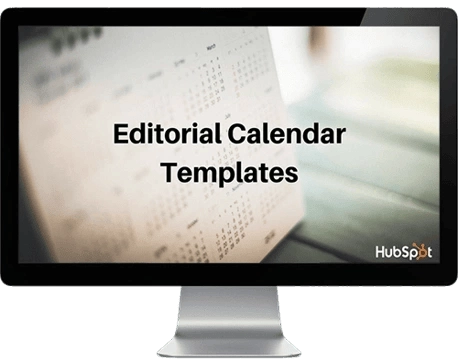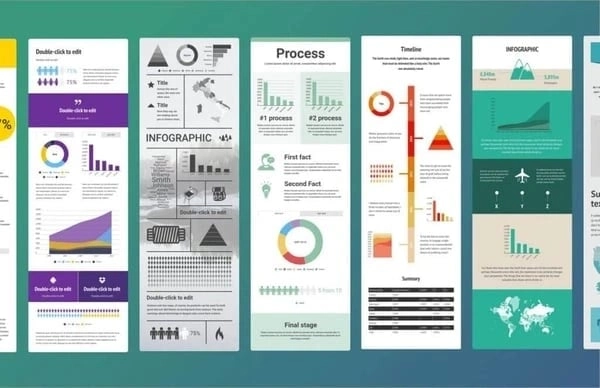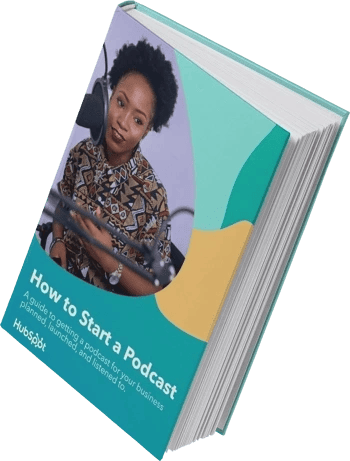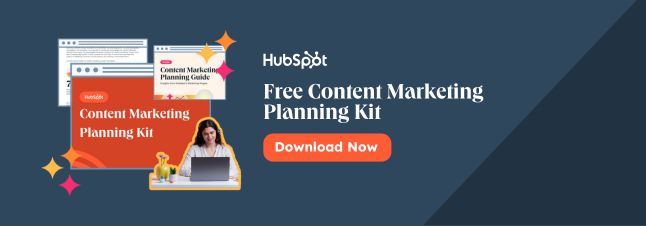Whether you‘re just starting out with content marketing or you’ve been using the same approach for a while, it never hurts to revisit your content strategy plan and make sure it's innovative and engaging for your prospects and customers.

If you're having trouble planning for the upcoming year or need some fresh ideas to include in your plan, read on.
In this post, we'll dive into what content strategy is, why your business needs a content marketing plan, and what steps you need to take to create your strategy.
Plus, we'll explore some examples of effective content marketing strategies for inspiration.
Table of Contents
- What is content strategy?
- Why Marketers Need to Create a Content Marketing Strategy
- Elements of a Content Strategy Plan
- How to Create a Content Strategy Framework
- Content Marketing Strategy Statistics
- Questions to Ask When Creating a Content Strategy
- Content Strategy Template
- Content Marketing Strategy Example
- Content Strategy Tactics
What is content strategy?
A content strategy is the planning, creation, publication, management, and governance of content. A great content strategy will attract and engage a target audience, meeting their needs while driving business goals.
Say your business goals include increasing brand awareness.
To achieve this, you might implement a content strategy that focuses on SEO to increase your website's visibility on the search engine results pages (SERPs) and drive traffic to your products or services.
New business owners might assume a content strategy is a nice-to-have, but not necessary early on. However, producing high-quality content can be invaluable in building trust with new audiences and succeeding in the long haul.
In essence, a good content strategy is the foundation of your Attract and Delight stages in a buyer's journey that follows the inbound marketing framework.
Along with attracting prospects to your brand, you can leverage a content strategy for sales enablement and customer satisfaction.
Plus, with 70% of marketers actively investing in content marketing, it's critical to develop a good content strategy to compete in your industry.
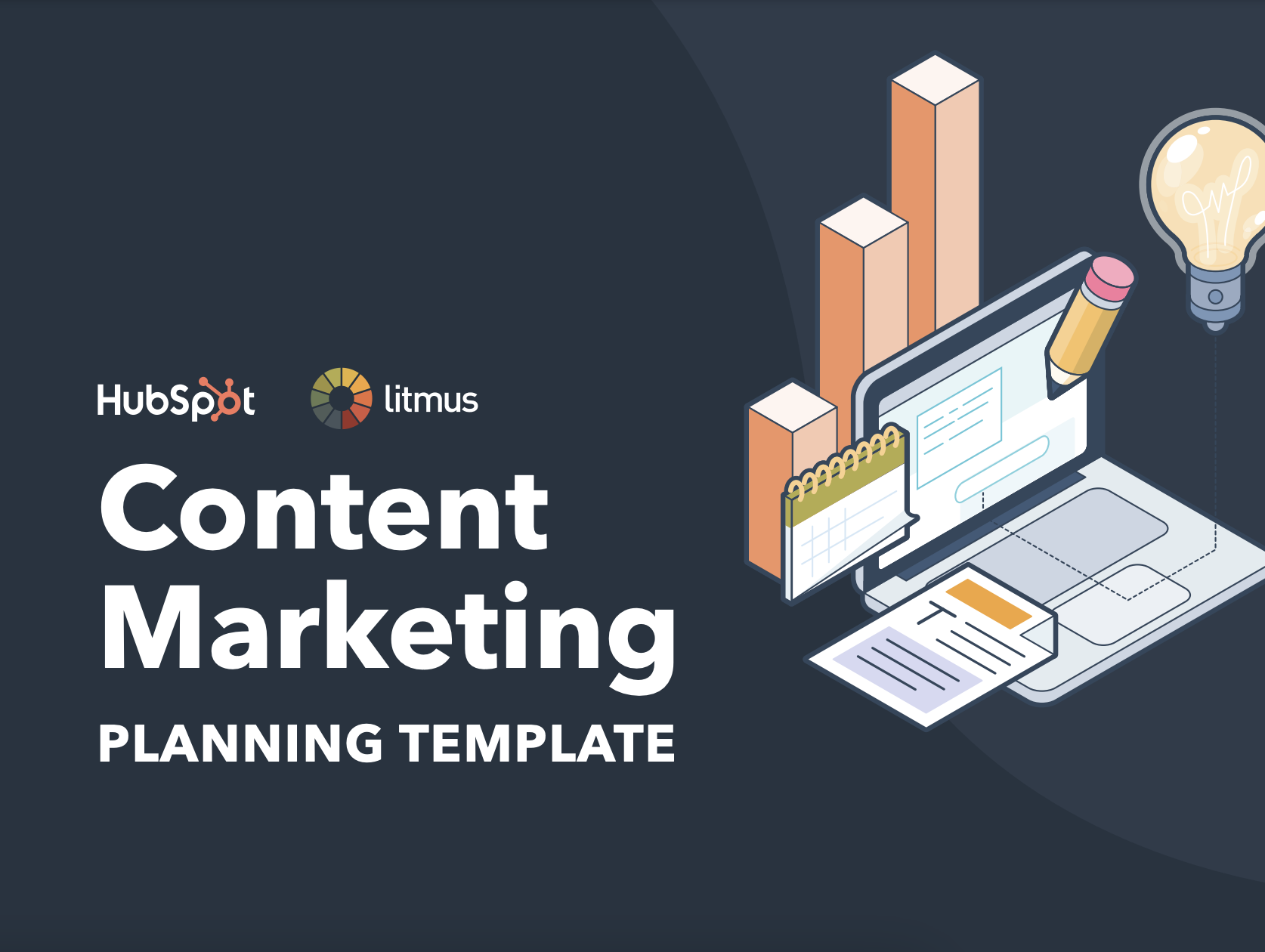
Content Marketing Planning Templates
Plan your content strategically with these handy templates.
- Editorial Calendar Template
- Buyer Persona Templates
- SWOT Analysis Templates
- SMART Goal Template
Why Marketers Need to Create a Content Marketing Strategy
A couple of years ago, I worked as a content writer for a literary company that just launched.
Despite all the meetings the team had before the launch, the founder and CEO of the company didn’t understand why it was important to create a content marketing strategy we’d adhere to when the website went live.
Three months after the launch, the CEO called another meeting and expressed their dissatisfaction with the poor performance so far.
Both the website and the company’s social media profiles were receiving crickets by way of organic traffic, and the paid ads were not converting at all.
I suggested that we create a content strategy plan for the next quarter and see what happens.
We did that, and sure enough, by the end of Q2, we recorded an increase in traffic and conversions from both the website and social media profiles.
No matter the kind of company or industry you work in, a content marketing strategy is integral for the success of your digital marketing efforts.
Here are some reasons why.
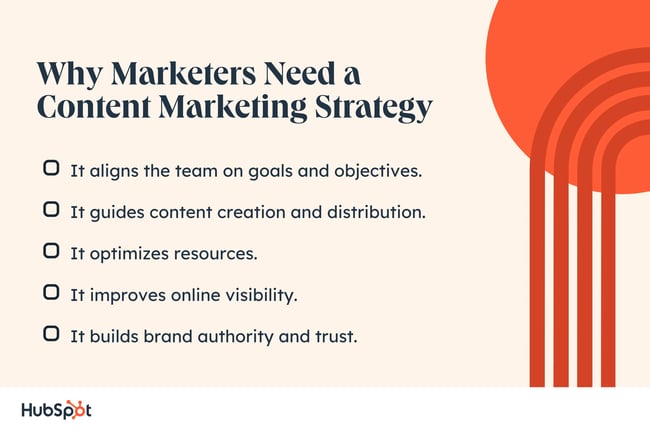
1. It aligns the team on goals and objectives.
A content marketing strategy ensures that everyone on the marketing team understands the overarching goals and specific objectives of the business.
When content creators, social media managers, writers, and other team members are aligned on goals such as brand awareness, lead generation, or customer engagement, they can produce content that consistently supports these aims.
This increases the chances of getting tangible results.
Carl Broadbent, a digital marketing expert, values content marketing strategies for the alignment they bring.
“After years of publishing blogs, ebooks, and videos, I‘ve learned that a strong content strategy acts like a guiding compass. It points you towards topics and formats aligned with business goals, so you’re not just cranking out content for content's sake,” Broadbent says.
Broadbent also notes that teams will make mistakes along the way.
He recalls, “‘I've made that mistake! Last year, we invested heavily in podcasts, thinking it would attract our target buyers. Turns out our audience preferred snappy infographics. Our podcast push fizzled out fast without the right strategy in place.”
2. It guides content creation and distribution.
Ayomide Joseph, a freelance content marketer for SaaS companies like Aura, Nextiva, and Trengo, explains the purpose of a content marketing strategy:
“The concept of ‘strategy’ in content marketing is simply to give you a roadmap that’ll guide you from where you are to where you want to be,” Joseph says.
For example, Joseph notes that if you’re looking to drive more inbound leads via content, ideally, creating bottom-of-the-funnel content is the way to go.
“A content marketing strategy answers the questions, ‘How do you go about it? What’s the keyword you’re going to target, search volume, difficulty — and what distribution approach will you utilize?’” Joseph says. “If you don’t have a content marketing strategy, you’ll be working blind.”
A content marketing strategy requires you to plan the type of content to create, such as blog posts, infographics, videos, and podcasts.
You’ll also determine the most effective channels for distribution, whether that be social media platforms, email marketing, or the company’s website.
This planning ensures that content is consistent, timely, and relevant to the audience’s interests and needs, fostering brand loyalty and advocacy.
3. It optimizes resources.
When you map out a fully-fledged content marketing strategy, you’ll be able to allocate resources more efficiently, whether those resources are time, budget, or manpower, to bring the strategy to life.
By knowing the type of content you need to produce and the platforms through which you’ll distribute it, you can direct your efforts and budget toward activities that offer the best return on investment (ROI).
4. It improves online visibility.
A well-executed content marketing strategy can alleviate this problem by improving a brand’s visibility in search engine results pages (SERPs).
High-quality, optimized content is favored by search engines and ranks higher in search results, which leads to increased organic traffic.
By targeting specific keywords and topics relevant to your target audience, you can attract more qualified leads to your website.
5. It builds brand authority and trust.
By consistently producing high-quality, relevant, and valuable content, you can establish your business as a thought leader in its industry.
This authority builds trust with your audience, which is crucial for long-term relationships and customer loyalty.
A content marketing strategy ensures that your content not only attracts attention but also provides value and encourages your audience to return and interact with the brand further.
Elements of a Content Strategy Plan
Since a content strategy plan is a roadmap designed to guide the creation, publication, and governance of useful content, here are some key elements you should include when creating yours.
1. Goals and Objectives
What do you want to achieve with your content?
Do you want to increase brand awareness? Generate leads? Or maybe, improve customer engagement? Is it all three — or something else?
When you define the goals and objectives you want your content to help you achieve, you’re establishing your North Star.
So, if you’re not sure whether to include a certain type of content in your strategy, you can look to your North Star and determine if that content type will lead you in the direction you want to go.
2. Audience Persona
An audience persona (or buyer persona) is a semi-fictional representation of your ideal customer based on data and research.
It helps you understand who you’re creating content for.
To create an accurate audience persona, you’ll need to conduct research through surveys and interviews and analyze your social media engagement to gather insights.
These insights include your audience’s demographic information, interests, pain points, and content preferences, to mention a few.
Knowing this information will help you understand the content types, topics, and marketing channels that will help you reach your goals.
3. Content Audit and Analysis
Once you’ve gotten your audience persona down, review your existing content to determine what’s working and what’s not.
This way, you’ll be able to identify gaps and opportunities for content.
In the Content Audit section of your content strategy plan, explain:
- The kinds of content and topics that are already working well for you (e.g., blogs that discuss web development, micro-videos that explain coding tips and tricks, etc.)
- The kinds of content and topics that are not gaining traction (e.g., white papers about the evolution of programming)
- The content gaps and opportunities you’ve discovered
Pro tip: Use tools like Google Analytics and social media analytics to evaluate the performance of your content. Look for patterns in what types of content perform best and use this to inform future content creation.
4. Content Types and Channels
Next, decide on the types of content you will create (e.g., blog posts, videos, infographics) and the marketing channels through which you will distribute them (e.g., website, social media, email).
Ensure that you choose these content types and channels based on your audience’s preferences and where they spend their time online.
Consider experimenting with different formats and channels and measuring their effectiveness before choosing your ideal marketing mix.
5. Content Creation Process
This section of your content strategy plan outlines the steps for producing content, from idea generation to publication. This process includes assigning roles and responsibilities to other team members or freelancers.
Pro tip: Develop a content calendar to plan and schedule content in advance. Use collaboration tools to streamline the content creation process and ensure that team members (and/or freelancers) are on the same page.
6. Measurement and Analytics
Now you know your audience personas, the topics that make your audience tick, the channels you’ll use to distribute your content, and the content creation process.
The next step is to establish the metrics and key performance indicators (KPIs) to evaluate the success of your content.
Define clear metrics for each goal, such as engagement rates for brand awareness or conversion rates for lead generation.
Use analytics tools like Google Analytics and native social media analytics tools to regularly monitor performance and adapt your strategy as needed.
7. Content Governance
Content governance involves setting standards and policies for content creation, publication, and maintenance to ensure consistency and quality over time.
In this section of your content strategy plan, you’ll develop and include content style guidelines, tone of voice guidelines, and content quality criteria.
This ensures that your team members and/or freelancers create consistent and cohesive content.
How to Create a Content Strategy Framework
- Define your goal.
- Conduct persona research.
- Run a content audit.
- Choose a content management system.
- Determine which type of content you want to create.
- Brainstorm content ideas.
- Publish and manage your content.
Now, let's dive in to learn the specifics of how to create a content marketing plan.
Curious how former HubSpot Senior Director of Global Growth Aja Frost put together our content strategy? Here it is.
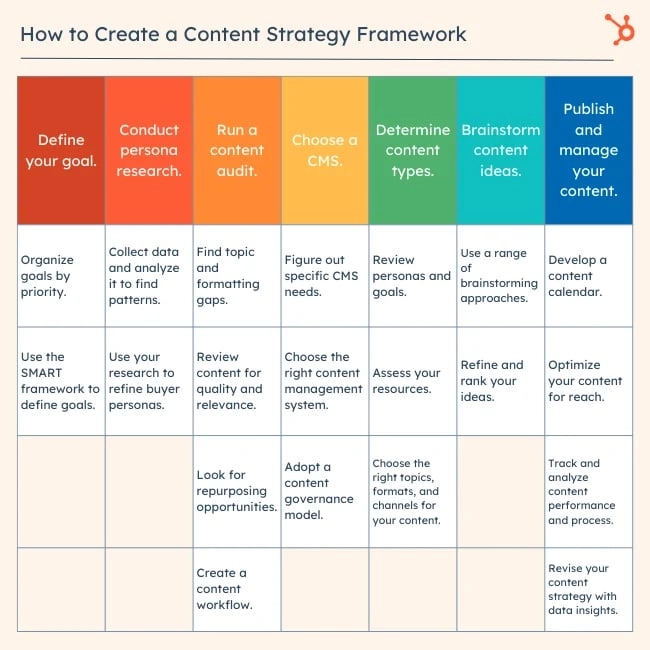
1. Define your goal.
What's your aim for developing a content marketing plan? Why do you want to produce content and create a content marketing plan?
It may seem obvious, but these questions are the core of a useful content strategy.
Look at high-level business goals, notes from meetings, and notes from your team, then do some solo research to make sure your goals have staying power.
Organize goals by priority.
Once you have a list of goals, rank them from most to least important.
This can help you decide which parts of your strategy are an immediate need and which are for long-term action.
This step can also help with resource questions later in the process.
Use the SMART framework to define goals.
The SMART framework can help you make broad goals more specific and actionable.
Know your goals before you begin planning, and you‘ll have an easier time determining what’s best for your strategy.
Download this goal-planning template to you figure out the right content goals.
2. Conduct persona research.
To develop a successful plan, you need to clearly define your content's target audience — also known as your buyer persona.
This is a crucial part of the planning phase of content strategy.
This is especially important for those who are new to marketing. By knowing your target audience, you can produce more relevant and valuable content that they'll want to read and convert on.
Collect data and analyze it to find patterns.
If you don‘t already have defined personas, you’ll want to analyze your data to find who you want to create content for and the types of content they enjoy.
This post has some useful tips for how to create buyer personas using your data.
As you analyze metrics like contact trends and demographics, group your leads by what they have in common first.
Then, look closely at these groups to find other similarities.
Use your research to refine buyer personas.
If you're an experienced marketer, your target may have changed.
Do you want to target a new group of people or expand your current target market? Do you want to keep the same target audience?
Revisiting your audience parameters by conducting market research each year is crucial to growing your audience. Taking a closer look at your current customer segments can also help you refine your personas.
Featured Tool: Buyer Persona Generator
3. Run a content audit.
Early on, many brands start with blog posts or social media.
If you want to venture out into different formats, you can run a content audit to assess your top-performing and lowest-performing content.
If you've been in business for a while, you should review your content marketing efforts and last year’s results.
Find topic and formatting gaps.
As you review your content, be sure to record page titles, content formats, word counts, and a summary of what your content covers.
This can help you find areas for improvement.
Review content for quality and relevance.
Next, analyze content quality and whether your content reflects what's most important to your audience.
Then, use that information to inform which direction you take next.
Look for repurposing opportunities.
There are many ways to repurpose content.
This strategy can help you optimize your content on multiple channels.
It might mean grabbing your most popular blogs and creating YouTube videos, an ebook, or launching a podcast with that content.
Check out this post for more content-recycling ideas.
Create a content workflow.
Another way to approach your audit is to look at your team's process.
Your content workflow impacts how you come up with ideas, what you publish, and the quality of your work.
Do you have a strategic workflow in place, or is your workflow organized around the habits of your team? An audit can help you see blocks and slow-downs that can affect your content long-term.
Use your content audit to figure out what you can do differently in the upcoming year and set new goals. Now is also a great time to align your team‘s goals with the rest of your organization’s goals.
Whatever stage you're in, a content audit will help you decide what resonates best with your audience, find gaps in your topic clusters, and process and brainstorm fresh content ideas.

Content Marketing Planning Templates
Plan your content strategically with these handy templates.
- Editorial Calendar Template
- Buyer Persona Templates
- SWOT Analysis Templates
- SMART Goal Template
4. Choose a content management system.
A few vital parts of content management include content creation, content publication, and content analytics.
You want to invest in a CMS to create, manage, and track your content in an easy and sustainable way.
Figure out specific CMS needs.
Finding the right CMS for your team may take some time.
First, talk to your team about their current processes to get a sense of the top features you'll need. Then, start researching the best CMS for your needs with this list.
A CMS for a business should be easy to use, customizable, secure, and cost-effective.
Choose the right content management system.
With the HubSpot CMS, you can plan, produce, publish, and measure your results all in one place.
Another popular CMS is WordPress, to which you can add the HubSpot WordPress plugin for free web forms, live chat, CRM access, email marketing, and analytics.
This list of the best content management systems offers a comparison between the tools above and other popular choices.
Adopt a content governance model.
As you get to know your new CMS, be sure to put a content governance model in place. This is a process to manage content creation, publishing, and maintenance.
It helps you make sure that each piece of content aligns with business standards and policies.
As your content presence grows, this model will also help you create processes for updating and removing outdated content.
5. Determine which type of content you want to create.
There are a variety of options out there for content you can create, from written content like ebooks and blog posts to audio content like podcasts.
Great content strategy is a balance of decision-making, data analysis, and risk-taking. Those skills will all be put to the test in this step.
Review personas and goals.
You may need different types of content for different personas and goals.
Take a careful look at your end goals and the actions you want each persona to take. Then, work backward to choose the right kind of content for each goal and user.
For example, say you're trying to decide between starting a blog or a podcast. Blogs tend to be better for conversion, while podcasts are great for building brand awareness.
Your goals and audience should be the deciding factor for which is best for your business.
Assess your resources.
Use a critical eye when you're reviewing the resources you have for content production.
Questions like the ones below can help you narrow your focus and create a sustainable content strategy.
- How big is your team?
- How much time does your team have to create content?
- What skills does your current team have?
- What types of content would you need training on, and what would you need to outsource?
- What is your content budget?
Choose the right topics, formats, and channels for your content.
Using your personas, choose a set number of high-level topics to focus your content on. Then, using your audience and topic choices, narrow down your chosen content formats and channels.
For example, say your team is launching a video channel, but they don‘t have a lot of experience. You might consider creating video shorts.
But if rankings for that topic tend to be long-form videos or podcasts, you’ll want to think about that decision — do you want to stand out and hope your audience pivots to a new format?
Or should you get help creating the content you think will top the current competitive landscape for your topic?
Once you’ve made these big decisions about your content strategy, you’ll be ready to get into the details.
6. Brainstorm content ideas.
Use your content audit, persona research, and goals to make the best content decisions for your business.
A quick review of this information before brainstorming can help you keep these insights top-of-mind.
Use a range of brainstorming approaches.
Next, it's time to start coming up with ideas for your next content project.
Here are some tools to get the juices flowing.
1. Feedly
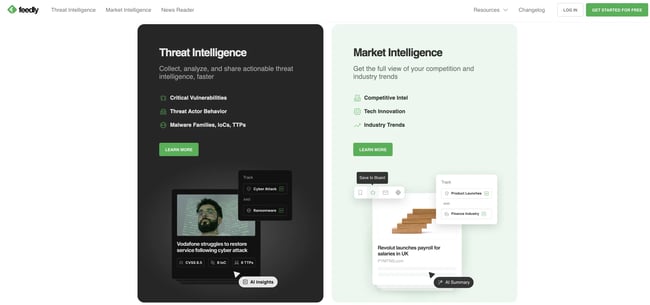
The Feedly RSS feed is a wonderful way to track trendy topics in your industry and find content ideas at the same time.
You start by telling the software what topics you're most interested in, and its AI tool will do the rest.
You won't need to scour the internet to find new content ideas anymore. Instead, you can go through your curated list, compiled from news sites, newsletters, and social media.
2. BuzzSumo
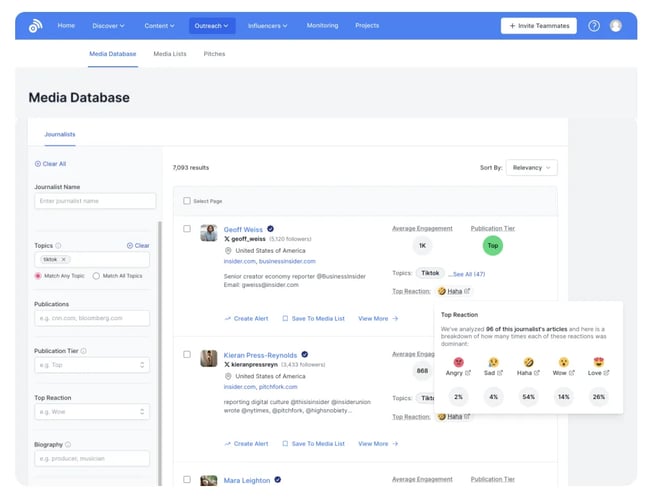
Want to discover popular content and content ideas?
This company offers several market research tools, one of which uses social media shares to figure out if a piece of content is popular and well-liked.
This information helps you see which content ideas would do well if you were to create content about them.
3. BlogAbout

Get your mind gears going with IMPACT's blog title generator.
This tool works a bit like Mad Libs, but instead of joke sentences, it shows you common headline formats with blanks where you can fill in the subject you have in mind.
This brainstorming technique helps you put general ideas in contexts that would be appealing to your target audience. Once you have a headline you like, BlogAbout lets you add it to your “Notebook” so you can save your best ideas.
4. CoSchedule Headline Analyzer

You can get blog post ideas for an entire year with HubSpot's Blog Ideas Generator.
All you need to do is enter general topics or terms you'd like to write about, and this content idea generator does all the work for you.
This tool analyzes headlines and titles and gives feedback on length, word choice, grammar, and keyword search volume.
If you have an idea in mind, run a few title options through the Headline Analyzer to see how you could make it stronger.
5. HubSpot's Website Grader

This is a great tool to use when you want to see where you're at with your website and SEO efforts.
The Website Grader grades you on vital areas of your website performance and sends you a detailed report to help you optimize.
With this tool, you can figure out how to make your website more SEO-friendly and discover areas of improvement.

Content Marketing Planning Templates
Plan your content strategically with these handy templates.
- Editorial Calendar Template
- Buyer Persona Templates
- SWOT Analysis Templates
- SMART Goal Template
Refine and rank your ideas.
The brainstorming process should be loose and unstructured.
It can be tempting to jump on an idea and start creating content right away. But instead, try to throw out your wildest ideas and see where they lead.
Then, take that list of content ideas and refine them.
To start, break ideas into groups and organize them around your goals, topics, or personas. Then, review each idea in detail and add specifics.
For example, say your topic is AI. One of your content ideas might be image generation. You can break this idea down further with content for image-generation tools, text-to-image prompts, or how to edit existing images.
Another way to refine content ideas is to conduct keyword research.
You can also define your process for refining ideas in your content workflow.
7. Publish and manage your content.
Your marketing plan should go beyond the types of content you‘ll create — it should also cover how you’ll organize your content.
Develop a content calendar.
With the help of an editorial calendar, you'll be on the right track to publishing a well-balanced and diverse content library on your website.
Then, create a social media content calendar to promote and manage your content on other sites.
Featured Tool: Free Editorial Calendar Templates
Optimize your content for reach.
Many of the ideas you think of will be evergreen (i.e., just as relevant months or years from now as they are today).
That being said, you shouldn't ignore timely topics either. While they may not be the bulk of your editorial calendar, they can help you generate spikes of traffic.
For example, most people count on incorporating popular holidays, like New Year‘s, in their marketing efforts. But you don’t have to limit yourself to these important marketing dates.
If there are niche holidays that might appeal to your audience, it could be worth publishing content on your blog or social media. Check out this ultimate list of social media holidays — check it when you're planning your calendar.
SEO tactics, cross-channel promotion, and channel-specific strategies (like social media strategy) are also key parts of content optimization.
Track and analyze content performance and process.
Analytics are essential to a strong content strategy.
Choose KPIs like traffic, engagement, lead generation, and conversion rates to measure the success of your content.
These resources can help you choose the best KPIs for each channel:
Revise your content strategy with data insights.
Don't just collect and review your data.
Connect it to your content strategy efforts. Review your KPIs for effectiveness, run marketing experiments, and use your data to adjust your strategy.
This analysis can also be helpful when you need support from stakeholders. It can sometimes be difficult to get the resources you need to test a risky idea.
Data-driven insights can support your case for trying new ideas with your content strategy.
Pro tip: Use Campaign Assistant to generate copy that fits your content strategy.
Content Marketing Strategy Statistics
Here are some statistics that show the results a content marketing strategy can help you generate for your business:
- 29% of marketers actively use content marketing. (HubSpot State of Marketing Report, 2024)
- 50% of marketers plan on increasing their investment in content marketing in 2024. (HubSpot State of Marketing Report, 2024)
- 15% of marketers find it challenging to generate traffic and leads for their business. (HubSpot Marketing Trends Report, 2024)
- 17% of marketers say that short-form videos are a trend that has generated strong results for their businesses. (HubSpot Marketing Trends Report, 2024)
- 13% of marketers are using voice search optimization (Alexa, Siri, etc.) as part of their marketing strategy. (HubSpot Marketing Trends Report, 2024)
- 90% of social media marketers say building an active online community is crucial to a successful social media strategy. (HubSpot State of Marketing Report, 2023)
Questions to Ask When Creating a Content Strategy
When you develop a content strategy, there are a few questions to answer. Let's dive into those now.
1. Who will be reading your content?
Who's the target audience for your content? For how many audiences are you creating content?
Just as your business might have more than one type of customer, your content strategy can cater to more than one type of user.
Using a variety of content types and channels will help you deliver content that's tailored to each persona.
2. What problem will you be solving for your audience(s)?
Ideally, your product or service solves a problem you know your audience has.
By the same token, your content coaches and educates your audience through this problem as they begin to notice and address it.
A sound content strategy supports people on both sides of your product: those who are still figuring out what their main challenges are and those who are already using your product to overcome these challenges.
Your content reinforces the solution(s) you're offering and helps you build credibility with your target audience.
3. What makes you unique?
Your competitors likely have a similar product as yours, which means your potential customers need to know what makes yours better — or, at least, different.
Maybe your main asset is that your company has been established for many years. Or perhaps you have a unique brand voice that makes you stand out from your competitors.
To prove why you‘re worth buying from, you need to prove why you’re worth listening to. Once you figure that out, permeate that message in your content.
4. What content formats will you focus on?
To figure out what formats to focus on, you need to meet your audience where they are.
While you may be tempted to launch a podcast or launch a YouTube channel, find out first where your audience lives.
Otherwise, you may waste time creating content that either won't reach your audience or capture their attention.
Once you choose the best formats, start creating a budget to assess what resources you can allocate to execute this strategy.
5. What channels will you publish on?
Just as you can create content in different formats, you'll also have various channels you can publish to, from your website to social media.
This part of your content strategy, again, will show where your audience lives.
If your audience prefers long-form video content, you may opt to publish your content on YouTube. If you have a younger audience that likes quick content, you may opt for TikTok and Instagram.

Content Marketing Planning Templates
Plan your content strategically with these handy templates.
- Editorial Calendar Template
- Buyer Persona Templates
- SWOT Analysis Templates
- SMART Goal Template
6. How will you manage content creation and publication?
Figuring out how you'll create and publish all your content can be a daunting task.
Before you execute, it's important to establish:
- Who's creating what.
- Where it's being published.
- When it's going live.
In a small team, this may be easy enough as you may be the sole decision-maker. As your company grows, you may need to collaborate with several content teams to figure out an effective process.
Today's content strategies prevent clutter by managing content from a topic standpoint.
When planning a content editorial calendar around topics, you can easily visualize your company's message and assert yourself as an authority in your market over time.
Content Strategy Template
Ready to get started with your own content marketing strategy? Download this helpful workbook.
It includes key readings and activities to help you fine-tune your plan and develop a robust strategy. You'll learn how to:
- Generate content ideas.
- Create topic clusters and pillar pages.
- Promote your content.
- Repurpose your content based on your needs.
Content Marketing Strategy Example
To understand what a content strategy is, let's consider the following scenario:
A prospect calls a sales representative at Wistia and asks questions related to Wistia's video hosting service. As the Wistia sales rep speaks with her, he learns her business is using a few other tools to convert leads into sales, including Intercom.
Bingo.
Once the call ends, the sales rep sends the prospect a follow-up email with a blog post about Wistia's integration with Intercom, which enables Intercom users to further personalize messages to prospects based on video-watching data they collect through Wistia.
This is a prime example of how you might use a content strategy as a sales enablement tool.
On the surface, it might seem odd that Wistia has dedicated content about another business tool.
However, this content is a great resource for Wistia‘s sales team, particularly when prospects have concerns about how Wistia’s product can integrate with their existing software or processes.
Content Strategy Tactics
- Blog Posts
- Ebooks
- Case Studies
- Templates
- Infographics
- Videos
- Podcasts
- Social Media
Putting a content strategy in place means that you need a firm understanding of content tactics.
Content Strategy vs. Content Tactics
Content tactics are the actions you take to deliver your content strategy.
Content strategy defines the why and how of your content programming as a whole. Content tactics define the types of content you create and how you create each piece of content.
Both are important to a successful content marketing program.
These are the eight most popular types of content marketing you can create for your readers and customers.

Content Marketing Planning Templates
Plan your content strategically with these handy templates.
- Editorial Calendar Template
- Buyer Persona Templates
- SWOT Analysis Templates
- SMART Goal Template
1. Blog Posts
If you haven‘t already noticed, you’re currently reading a blog post.
Blog posts live on a website and should be published regularly to attract new visitors. In fact, 16% of marketers say that their blog posts generated the biggest ROI for their businesses this year.
Blog posts should offer valuable content for your audience that makes them inclined to share posts on social media and across other websites.
We recommend that posts be between 1,000 and 2,000 words in length, but you should experiment to see if your audience prefers longer or shorter reads.
Featured Tool: 6 Free Blog Post Templates

Check out our free blog post templates for writing great how-to, listicle, curation, SlideShare presentation, and newsjacking posts on your own blog.
2. Ebooks
Ebooks are lead-generation tools that website visitors download after submitting a lead form with their contact information.
They're typically longer, more in-depth, and published less often than blog posts, which are written to attract visitors to a website.
But ebooks aren't only effective for the top of the funnel.
As Nora Leary, Growth Director at Ironpaper, Inc., notes, “Ebooks serve different purposes at varying stages in the buyer's journey.”
She told me, “Awareness-level ebooks help educate the prospect about a certain pain point and are an excellent lead capture tool. The content should remain introductory and informational.”
Leary adds, "Ebooks can convert leads in the funnel by offering them useful tools as prospects consider their needs more in-depth.
An ebook here might dive deeper into a particular problem and solution options and include templates or calculators.
[Lastly,] ebooks further down the funnel should become more personalized and offer more sales content. Comparison guides or an ebook of case studies are beneficial for prospects at this stage."
Ebooks are the next step in the inbound marketing process. After reading a blog post, visitors might want more information.
This is where calls-to-action (CTAs) come into play, directing people to a landing page where they can submit their contact information and download an ebook to learn more valuable information for their business.
In turn, the business producing the ebook has a new lead for the sales team to contact.
Featured Tool: 18 Free Ebook Templates
3. Case Studies
A case study allows you to tell a customer story and build credibility in the process.
A case study is perhaps your most versatile type of content marketing because it can take many different forms — some of which are on this list. That's right, case studies can take the form of a blog post, ebook, podcast, or even an infographic.
The goal is to show how your product helped real-life companies succeed. Before choosing a customer for a case study, narrow in on the business area you're trying to drive value for.
Featured Tool: 3 Free Case Study Templates
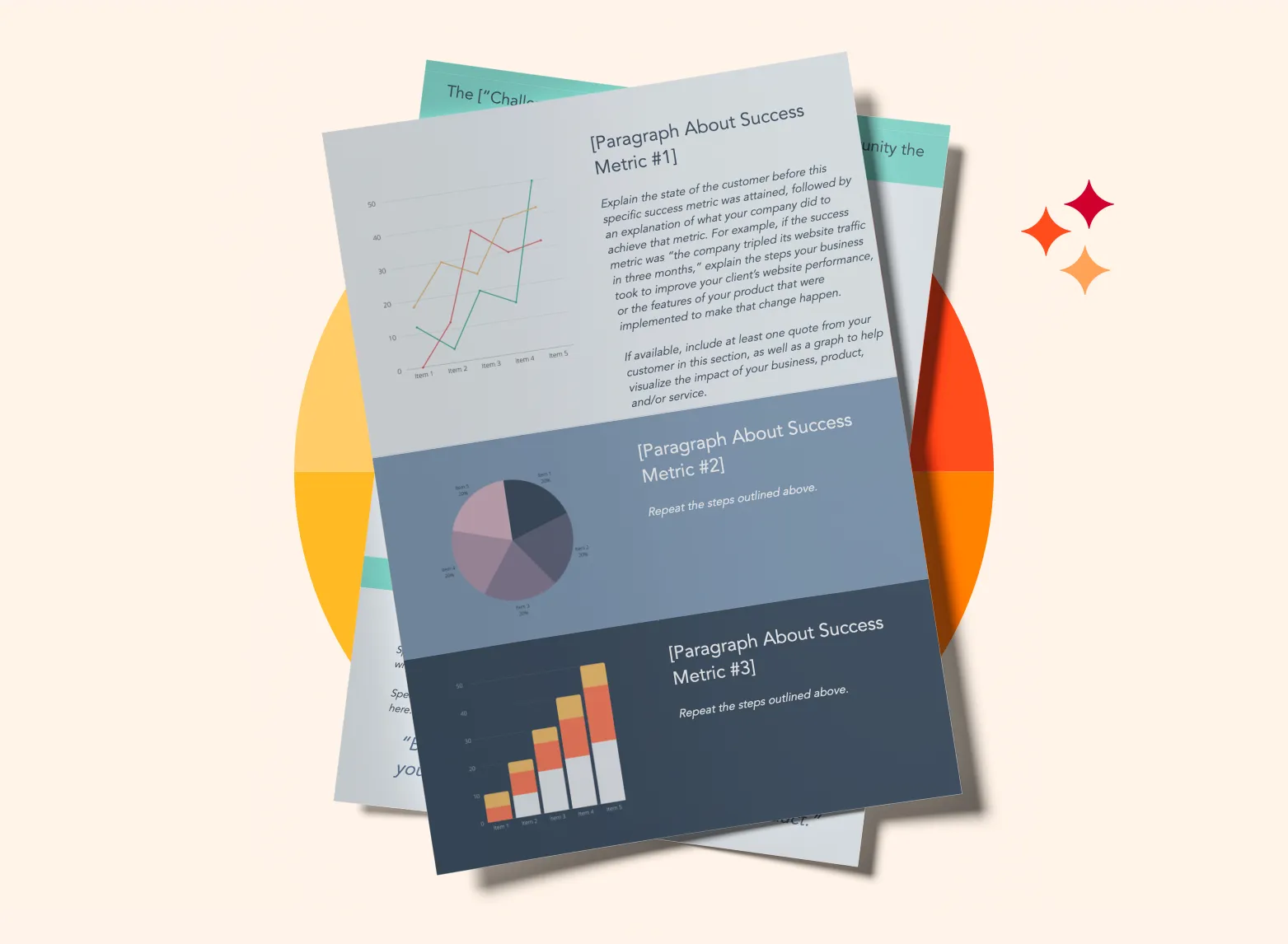
4. Templates
Templates are effective content marketing examples to try because they generate leads while offering tremendous value to your audience.
When you offer your audience templates to save them time and help them succeed, they're more likely to engage with your content in the future.
5. Infographics
Infographics can organize and visualize data in a more compelling way than words alone.
These are great content formats to use if you're trying to share a lot of data in a way that is clear and easy to understand.
Featured Tool: 15 Free Infographic Templates
If you're ready to get started, get our templates for creating beautiful infographics in less than an hour.
6. Videos
Videos are a highly engaging content medium and are shareable across social media platforms and websites alike.
Videos require a bigger investment of time and resources than written content, but as visual content continues to offer big ROI, it's a medium worth exploring.
Featured Tool: Free Video Marketing Starter Pack + Templates
7. Podcasts
Starting a podcast will help audiences find your brand if they don't have time or interest in reading content every day.
The number of podcast listeners is growing — in 2022, there was a 6% year-over-year increase in U.S. podcast listeners.
If you have interesting people to interview or conversations to host, consider podcasting as another content format to experiment with.
Featured Tool: How to Start a Podcast [Guide + Templates]
8. Social Media
Once you've been regularly publishing content on your own site for a while, start thinking about a social media strategy to distribute your content on social media.
In addition to sharing your content, you can also repurpose it into new formats and create original content specifically for each platform.
Posting on social media is pivotal to amplifying your brand's reach and delivering your content to your customers where you know they spend their time. Popular social networks include:
When launching a business account on any of the social networks above, adjust your content to the platform.
On Instagram, for example, users want aesthetically pleasing visuals.
With feeds, IGTV, Stories, you have a lot of room to play with. TikTok, on the other hand, appeals to a younger demographic that wants trendy, funny, and creative short-form videos.
Do some market research to discover which platforms your buyers are on, and mold your content to their expectations.
Content strategy is more than planning and maintenance.
It takes time, organization, and creativity to grow a successful content marketing strategy.
From building the foundation of your content marketing plan to adding tools to better manage your content, setting up your strategy won't be a hassle if you follow the steps and explore the resources here.
Editor's note: This post was originally published in September 2018 and has been updated for comprehensiveness.

